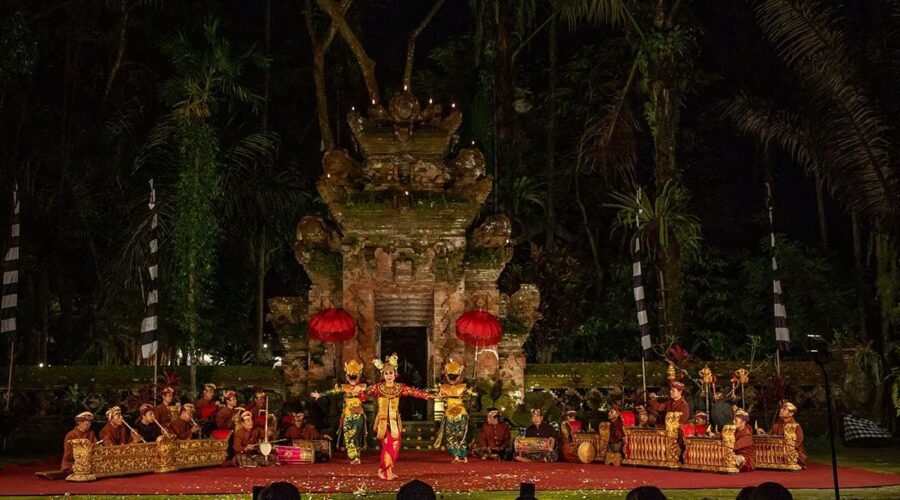Balinese Traditional Music: Discover the Unique Balinese Gamelan and the Vibrant Music of Bali
Bali, a picturesque island in the Indonesian archipelago, is globally celebrated for its stunning landscapes and rich cultural traditions. Among its many artistic treasures, Balinese traditional music occupies a special place as a cornerstone of the island’s identity. Featuring a mix of gongs, flutes, bamboo xylophones, and kendang instruments, this music is not just an art form but also a vital element of religious ceremonies, village life, and theatrical performances. With its intricate melodies and unique instrumentation, Balinese traditional music has enchanted audiences both locally and worldwide. Let’s embark on a journey to explore the fascinating realm of Balinese traditional music and its cultural significance.
Exploring Balinese Traditional Music: A Harmony of Instruments, Dance, and Culture
Balinese traditional music embodies the island’s vibrant spirit and deep cultural roots. Its signature sound comes from the gamelan ensembles, a collection of gongs, metallophones, drums, and bamboo instruments that produce an intricate symphony of rhythms and tones. This music often accompanies traditional Balinese dances and religious ceremonies, reflecting Bali’s Hindu heritage and devotion to deities such as Sang Hyang Guru. Beyond its artistic beauty, Balinese traditional music serves as a medium for storytelling, spiritual connection, and communal harmony.
Music of Bali: The Core of Cultural Heritage
The music of Bali is distinct from other Indonesian musical styles, particularly the Javanese gamelan. While Javanese music often features meditative and slower tempos, Balinese gamelan music is characterized by faster beats and rhythms, creating a dynamic and engaging auditory experience. This vibrant music is deeply integrated into the daily lives of the Balinese people, marking occasions such as temple ceremonies, funerals, and festivals.
Gamelan Music: The Heartbeat of Bali
The beating heart of Balinese music is the gamelan ensemble, which forms the backbone of almost every musical performance. A typical gamelan orchestra consists of bronze and bamboo instruments, metallophones, kendang drums, and suling flutes. The unique interplay of these instruments creates a hypnotic soundscape that has become synonymous with Balinese traditional music.
Gamelan Ensemble: A Symphony of Instruments
Distinct Characteristics of Balinese Gamelan Ensembles
The gamelan ensemble in Bali differs significantly from its Javanese counterparts. Balinese gamelan music features louder dynamics, swifter and more aggressive tempos, and a layered texture that captivates audiences. This distinctive style is a hallmark of Balinese traditional music, setting it apart as a unique expression of the island’s cultural identity.
Instruments Include Bronze and Bamboo
The instruments in a Balinese gamelan ensemble are crafted from a combination of bronze and bamboo, materials that produce a harmonious blend of sounds. Notable examples include the jegog, a bamboo xylophone with a deep tone, and the reyong, a set of small gongs played in rapid succession. These instruments are arranged in various sizes and tuned to specific tonal scales, creating a rich and resonant sound.
Instruments of Balinese Gamelan Music
Key Instruments in a Gamelan Ensemble
- Metallophones: These instruments, made of bronze bars, produce the melodic foundation of the music.
- Gongs: Large, hanging gongs mark the cyclical structure of the music.
- Kendang Drums: The kendang instruments provide the rhythm and guide the ensemble’s tempo.
- Suling Flutes: Bamboo flutes add a melodic and airy quality to the music.
- Rebab: A bowed string instrument used to enhance the melodic texture.
Every instrument contributes to the layered complexity of Balinese traditional music, making it one of the most fascinating art forms in Southeast Asia.
Cultural Significance of Music in Bali
Rituals and Religious Rites
Music in Bali is deeply intertwined with spiritual practices and religious ceremonies. During temple festivals, gamelan orchestras create a sacred atmosphere that uplifts worshippers and connects them to divine energies. Ceremonies like Hindu rituals are incomplete without the presence of Balinese traditional music, which serves as a medium for communication with the spiritual realm.
Storytelling and Wayang Performances
The role of gamelan music extends beyond rituals. It also accompanies wayang shadow puppet performances, a traditional form of storytelling that conveys moral and spiritual lessons. The gamelan orchestra provides a dynamic backdrop for these tales, enhancing the drama and emotion of the narrative.
Modern Adaptations and Global Influence
Balinese Music in Tourism
The enchanting sounds of Balinese traditional music have become a major draw for tourists. In regions like Gianyar, visitors can witness live performances that showcase the island’s artistic heritage. These performances often include traditional dances, such as the Legong and Barong, accompanied by Balinese traditional music.
Balinese Gamelan on Digital Platforms
With the rise of digital platforms, audiences worldwide can now listen to gamelan through curated playlists and videos. YouTube, in particular, offers a window into the world of Balinese traditional music, making it accessible to people across the globe.
Preservation of Balinese Traditional Music
Education and Community Efforts
Preserving the legacy of Balinese traditional music involves passing down knowledge through community workshops and schools. In many villages, young musicians are trained to play instruments like the mallet, ensuring the survival of this art form.
Integration with Modern Music
Musicians today are blending Balinese traditional music with contemporary genres, creating innovative sounds that appeal to a global audience. This fusion not only keeps the tradition alive but also introduces Balinese traditional music to new listeners.
Balinese Instruments and Their Unique Sounds
Diversity in Instrumentation
The instruments used in Balinese gamelan ensembles come in various forms and sizes, each contributing a unique tone to the music. From the cymbals that accentuate rhythm to the jegog that provides bass undertones, every element plays a crucial role in creating the ensemble’s signature sound.
Archaic Instrumentation
While Balinese gamelan also features modern instruments, it retains elements of archaic instrumentation that add a sense of timelessness. These instruments, crafted from traditional materials, reflect the island’s dedication to preserving its heritage.
Conclusion
Balinese traditional music is a remarkable blend of artistry, spirituality, and cultural heritage. Its vibrant rhythms, intricate instrumentation, and profound connection to Balinese life make it a true treasure of the Indonesian island. Whether experienced during a temple ceremony, a village festival, or through a digital playlist, the music continues to captivate and inspire. As we celebrate and preserve this unique art form, we ensure that the harmonious legacy of Balinese traditional music will endure for generations to come.
Experiencing Balinese traditional music, particularly gamelan performances, is a highlight for many visitors to Bali. While several hotels offer such cultural showcases, one notable establishment is the ARMA Resort (Agung Rai Museum of Art Resort) in Ubud. This resort is dedicated to promoting and preserving traditional Balinese arts, including regular gamelan performances.
Read more: The Ultimate Guide to Bali Meditation Retreats for Yoga Wellness and Tranquility in Ubud



